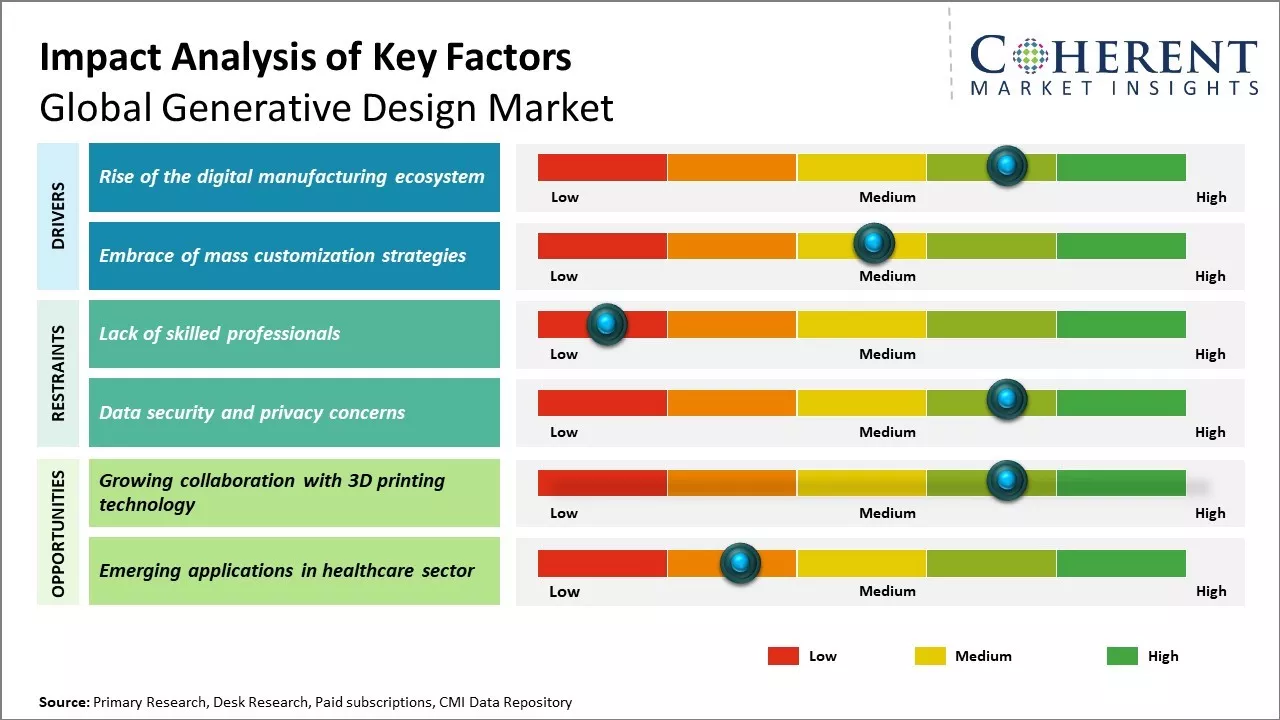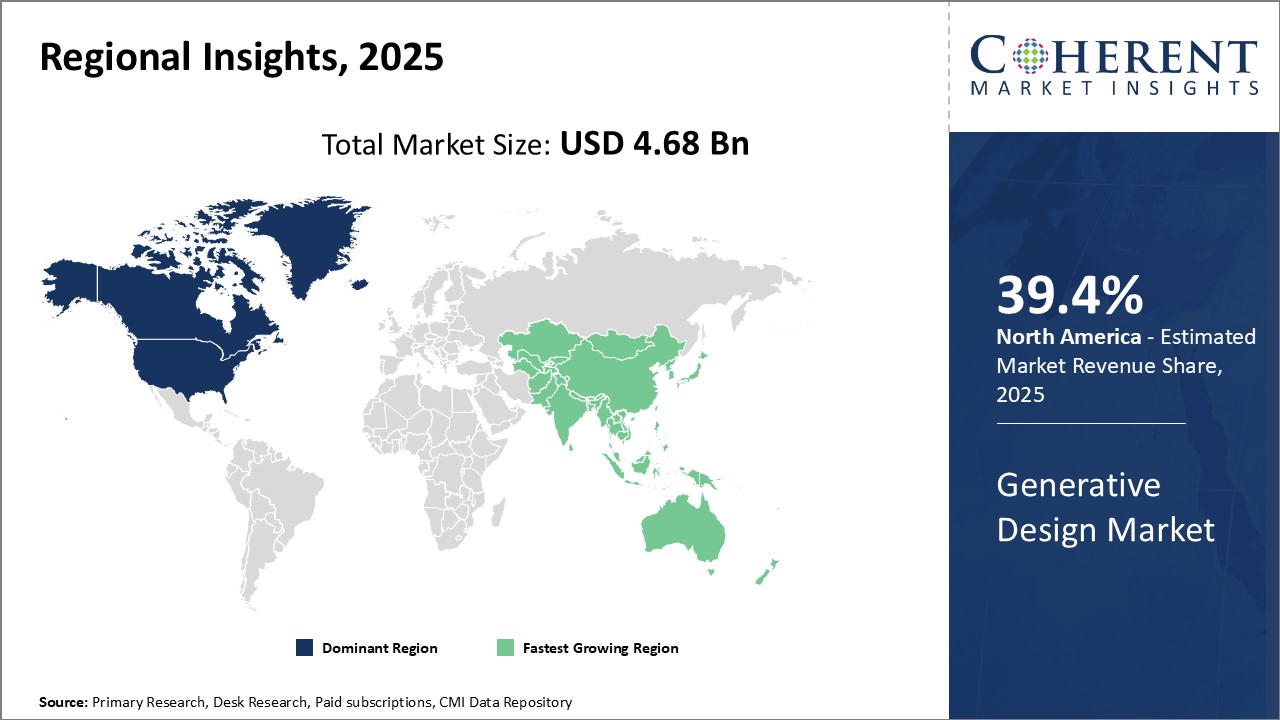
The Global Generative Design Market is estimated to be valued at US$ 4.68 Bn in 2025 and is expected to reach US$ 13.65 Bn by 2032, exhibiting a compound annual growth rate (CAGR) of 16.5% from 2025 to 2032.

Discover market dynamics shaping the industry: Download Free Sample
The global generative design market growth can be attributed to the increasing adoption of advanced designing software tools across industries. Generative design helps reduce production costs and development time by creating efficient designs. It allows generating thousands of design options by manipulating various parameters and finding optimum solutions. This optimizes structural performance and improves manufacturability of products. Rising focus on simulation-driven product development and growing complexity of product designs are some key factors driving the increased adoption of generative design tools. Integration of advanced technologies like AI and machine learning is further enhancing the capabilities of these solutions. This is expected to present lucrative opportunities for vendors during the forecast period.
Rise of the digital manufacturing ecosystem
The manufacturing industry has seen tremendous advancements in digital technologies in recent years. Traditionally, product design and manufacturing were linear processes that involved conceptualizing a design on paper, creating engineering drawings, and then manufacturing physical prototypes through trial and error. However, with the growth of digitalization, this process has become highly interactive and data-driven. Technologies like 3D printing, CAD modelling, simulation tools, augmented/virtual reality, and internet of things (IoT) enabled sensors allow designers to test and refine product concepts virtually before committing to physical prototypes.
Generative design tools are well-suited for this digital manufacturing environment. By automating the iterative design process, they help designers quickly explore a wide design space and converge on optimal solutions based on multi-parametric performance criteria. This allows companies to develop better, lower cost and compliant products faster. The digitally defined designs also enable streamlined transfer of manufacturing instructions to 3D printing or CNC machines for making prototypes or production parts. Overall, as digital manufacturing gains adoption, generative design will be a key technology empowering the next generation of data-driven, collaborative and flexible product development workflows.

Get actionable strategies to beat competition: Download Free Sample
Embrace of mass customization strategies
Customers today expect tailored, personalized products and experiences across industries. Mass customization strategies allow companies to meet this demand of producing high-variety, low-volume products efficiently. However, designing for mass customization using traditional trial-and-error methods is resource-intensive and does not scale well. Generative design provides a solution by automating the configuration of customizable product families. Design teams can define common product platforms and flexible parameter ranges for customization. The generative algorithms then rapidly explore feasible designs within those constraints to find optimal configurations for individual customer requirements.
Key Takeaways from Analyst:
North America currently dominates the generative design space due to strong investments in research and development by automotive and aerospace companies in the region. However, the Asia Pacific market is expected to grow at the fastest pace during the forecast period. This can be attributed to rapid industrialization and infrastructure development projects in major Asian countries such as China and India. There is a growing focus on utilizing advanced technologies to enhance productivity and efficiency.
High initial costs of generative design software and need for skilled professionals to operate such solutions are some challenges restricting broader adoption. Integration of these solutions with existing workflows can also be complicated. However, the availability of cloud-based generative design platforms is improving access and reducing costs which is opening up opportunities for smaller organizations. Partnerships between software vendors and industry leaders are also helping to develop customized solutions for domain-specific challenges.
Market Challenges: Lack of skilled professionals
Lack of skilled professionals with expertise in generative design tools is a major challenge restraining the growth of the global generative design market. However, presently there exists a dearth of designers and engineers trained in using the specialized generative design software and interpreting the outputs. Transitioning to this new computational design paradigm requires significant reskilling of the existing workforce as well as developing new educational programs to train a fresh pool of generative design experts.
Market Opportunities: Growing collaboration with 3D printing technology
Growing collaboration between 3D printing technology and generative design presents a significant opportunity for the global generative design market. Generative design uses optimization algorithms to automate the generation and evaluation of different design alternatives that meet given goals or criteria. When combined with 3D printing technology's ability to rapidly produce physical parts from digital designs, generative design can revolutionize how products are conceived, tested and produced.
This collaboration allows designers and engineers to generate thousands of optimized design options that can then be effortlessly 3D printed and tested. Physical prototypes produced using generative design and 3D printing enable a more comprehensive evaluation of design trade-offs related to factors like strength, weight, functionality and aesthetics earlier in the product development process. Additionally, on-demand printing of optimized designs affords continuous refinement of prototypes based on learnings from testing. Overall, this workflow integrates physical testing and digital design loops, allowing for faster development of higher quality, more innovative products.

Discover high revenue pocket segments and roadmap to it: Download Free Sample
Insights By Deployment - Rising Demand for Flexibility and Scalability Drives Growth of Cloud-based Generative Design
The cloud-based segment currently contributes the 57.8% largest share of the global generative design market in 2025. Cloud deployment offers several advantages that appeal greatly to design teams across industries. Cloud solutions allow users to access design software from anywhere via an internet connection. This flexibility enables collaborations between teams located in different regions and time zones. The cloud model also eliminates the need for costly on-premise servers and periodic software upgrades. Maintenance, support and infrastructure are handled by the vendor, lowering IT expenses for customers.
The scalability of cloud-based generative design is another key driver of its segment leadership. Design workflows can fluctuate drastically depending on the stage of a project. During early stages, only a few designers may be utilizing the software. However, as projects move closer to production, several more stakeholders across engineering, manufacturing and other functions need to review and iterate on the designs. With cloud-based software, customers can easily add or remove user licenses as needs evolve. This ensures optimal usage of licenses without over-provisioning. The ability to rapidly scale computing power up or down based on demand also appeals to organizations working on unpredictable project timelines.
The subscription-based pricing model of cloud generative design allows for greater budgetary flexibility compared to sizable upfront licensing fees. Overall, the operational efficiencies and flexibility unlocked through cloud deployment have made it the goto choice for organizations looking to streamline generative design processes and collaborate globally. Consequently, the cloud-based segment is expected to continue dominating market share in the coming years.
Insights By Vertical - Automotive Sector Leads Adoption of Generative Design due to Complex Engineering Needs
Within the vertical segment breakdown, automotive contributes the 46% share to the global generative design market in 2025. Modern vehicle design and development involves solving intricate engineering problems to optimize performance metrics like weight, efficiency and safety. Generative design helps automakers virtually explore an exponentially larger design space to achieve better results than can be achieved manually.
Generative approaches are increasingly used from conceptual design stage to fine-tune individual components and sub-assemblies. For example, generative topology optimization helps minimize weight of load-bearing car parts without compromising strength. Automakers also leverage generative design to advance aerodynamic body shapes and cooling channel layouts for better heat transfer. Growing electrification of vehicles further drives uptake, as generative software aids complex thermal and fluid component design.
Tightening regulatory standards on factors like emissions and fuel consumption have also prompted the auto industry to adopt advanced digital tools to develop sustainable future vehicles. Moreover, generative design allows automakers to simulate, test and iterate on virtual prototypes faster than through physical building and testing. This accelerates vehicle development processes while reducing costs associated with physical prototyping. Overall, the sector's pressing engineering requirements make it the front runner in adopting and scaling up generative design solutions.

Need a Different Region or Segment? Download Free Sample
North America has established itself as the dominant region in the global generative design market with 39.4% share in 2025. The U.S., in particular, is home to many of the technology giants and industrial leaders that are pioneers in adopting and developing generative design technologies. This has been driven by the region's powerful digital infrastructure, highly skilled engineering workforce, and culture of innovation among businesses. American companies across industries like aerospace, automotive, and medical devices have been utilizing generative design to optimize products and streamline manufacturing processes.
Asia Pacific has emerged as the fastest growing regional market for generative design. Countries like China, India, Japan, and South Korea are witnessing increased adoption as their manufacturing industries adopt advanced technologies. With rising labor costs and a need to boost productivity, generative design is helping businesses in Asia Pacific enhance design workflows and produce high-quality customized goods more efficiently. Additionally, the availability of low-cost talent with engineering training has supported growth in the region. Strong government support for technical skills development and 'Make in India' incentives have created a conducive environment. Generative design firms have expanded operations to countries like India and China to capture new customers as well as collaborate with local manufacturing partners. Overall, the combination of a large industrial base and supportive policies are driving the rapid uptake of generative design technologies across Asia Pacific.
Generative Design Market Report Coverage
| Report Coverage | Details | ||
|---|---|---|---|
| Base Year: | 2024 | Market Size in 2025: | USD 4.68 Bn |
| Historical Data for: | 2020 To 2024 | Forecast Period: | 2025 To 2032 |
| Forecast Period 2025 to 2032 CAGR: | 16.5% | 2032 Value Projection: | USD 13.65 Bn |
| Geographies covered: |
|
||
| Segments covered: |
|
||
| Companies covered: |
Adobe Inc., Altair Engineering Inc., ANSYS Inc., Autodesk Inc., Bentley Systems Inc., Dassault Systèmes, Desktop Metal Inc., ESI Group, Google LLC, IBM Corporation, Microsoft Corporation, MSC Software, NVIDIA Corporation, Paramatters, and Siemens AG |
||
| Growth Drivers: |
|
||
| Restraints & Challenges: |
|
||
Uncover macros and micros vetted on 75+ parameters: Get instant access to report
*Definition: The global generative design market involves the use of advanced design and engineering software tools that leverage techniques such as artificial intelligence, machine learning, computational design, and other algorithms to automate portions of the product design process. Generative design software helps engineers and designers rapidly explore design options, optimize for multiple design criteria simultaneously, and uncover better performing design solutions faster than what is humanly possible through manual design iterations alone. This emerging technology is being adopted across industries aiming to accelerate product development cycles and drive innovation.
Share
Share
About Author
Monica Shevgan has 9+ years of experience in market research and business consulting driving client-centric product delivery of the Information and Communication Technology (ICT) team, enhancing client experiences, and shaping business strategy for optimal outcomes. Passionate about client success.
Missing comfort of reading report in your local language? Find your preferred language :
Transform your Strategy with Exclusive Trending Reports :
Frequently Asked Questions
Joining thousands of companies around the world committed to making the Excellent Business Solutions.
View All Our Clients